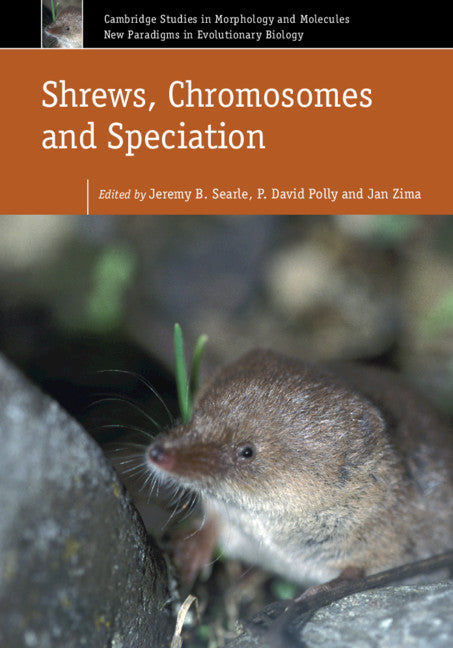Freshly Printed - allow 4 days lead
Couldn't load pickup availability
Shrews, Chromosomes and Speciation
Presents new insights into speciation through an in-depth analysis of extraordinary chromosomal variation in one species written by leading experts.
Jeremy B. Searle (Edited by), P. David Polly (Edited by), Jan Zima (Edited by)
9781107011373, Cambridge University Press
Hardback, published 28 February 2019
488 pages, 113 b/w illus. 23 tables
25.3 x 17.9 x 2.7 cm, 1.15 kg
'I found Shrews, Chromosomes and Speciation fascinating, and an enjoyable read. This volume will be a welcome addition to the library of any evolutionary biologist or graduate student interested in how the interactions of chromosomes and the genome shape diversity.' Sally Potter, The Quarterly Review of Biology
The chromosome complement (karyotype) often differs between related mammalian species (including humans vs chimpanzees), such that evolutionary biologists muse whether chromosomal difference is a cause or a consequence of speciation. The common shrew is an excellent model to investigate this problem because of its many geographical races (potential species) differing chromosomally, and its several sibling species (recently speciated forms) that are also chromosomally different. This system is an exceptional opportunity to investigate the role of chromosomes in speciation and this volume reflects detailed research following these approaches. Highlights include the demonstration that chromosomal re-arrangements can be associated with complete loss of gene flow and thus speciation and that selection within species hybrid zones may lead to de-speciation rather than speciation. This book represents an extraordinarily detailed consideration of the role of chromosomes in speciation in one astonishing species, providing insights to those interested in mammalian diversity, chromosomal evolution and speciation.
1. Milestones in common shrew chromosomal research Jan Zima and Jeremy B. Searle
2. Introducing the common shrew Nikolay A. Shchipanov, Jan Zima and Sara Churchfield
3. Morphology and genetics of the common shrew: general features Alina Mishta and Jeremy B. Searle
4. Phylogeography Susan Thaw, Thomas A. White, Anna A. Bannikova and Jeremy B. Searle
5. Chromosomal differentiation in the common shrew and related species Nina S. Bulatova, Larisa S. Biltueva, Svetlana V. Pavlova, Natalia S. Zhdanova and Jan Zima
6. Phylogenetic relationships of chromosomal races Thomas A. White, Jan M. Wojcik and Jeremy B. Searle
7. Meiosis and fertility associated with chromosomal heterozygosity Pavel M. Borodin, Stanis?aw Fedyk, W?odzimierz Ch?tnicki, Anna A. Torgasheva, Svetlana V. Pavlova and Jeremy B. Searle
8. Chromosomal hybrid zones Stanis?aw Fedyk, Svetlana V. Pavlova, W?odzimierz Ch?tnicki and Jeremy B. Searle
9. Gene flow between chromosomal races and species Glenn Yannic, Patrick Basset, Agnès Horn and Jacques Hausser
10. Geometric morphometric tests for phenotypic divergence between chromosomal races P. David Polly and Jan M. Wojcik
11. Is it really the chromosomes? Patrick Basset, Glenn Yannic and Jacques Hausser
12. Further divergence: the role of ecology and behaviour Boris I. Sheftel, Natalia V. Moraleva and Jacques Hausser
13. Climate, diversification and refugia in the common shrew: evidence from the fossil record P. David Polly
14. Shrews, chromosomes and speciation Jeremy B. Searle, Jan Zima and P. David Polly.
Subject Areas: Cellular biology [cytology PSF], Developmental biology [PSC], Genetics [non-medical PSAK], Evolution [PSAJ]


